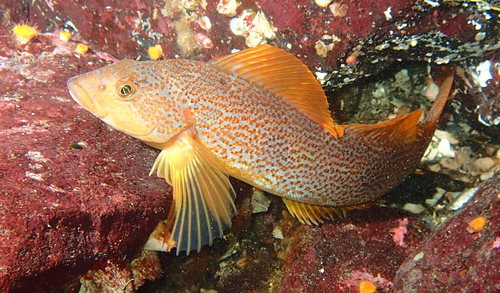
Kelp Greenling
The Atlantic bluefin tuna (Thunnus thynnus) is a magnificent and highly migratory species of tuna renowned for its size, speed, and commercial value. It plays a crucial role in marine ecosystems and holds significant cultural and economic importance. It's also a species that is endangered.
5 15 years
Lifespan
52 cm
Length
Least Concern
Conservation Status
N/A km/h
Swimming speed
Carnivorous
Diet
Local Migration
Migration
Appearance Overview
The Atlantic bluefin tuna is a large, torpedo-shaped fish with a streamlined body built for speed and endurance.
Color
Dark metallic blue on top, with a silvery-white underside
Fins
Two dorsal fins, the first depressible, and a series of finlets behind the second dorsal and anal fins
Body
Streamlined and powerful, adapted for high-speed swimming
Length
Up to 13 feet (4 meters), commonly around 6.5 feet (2 meters)
Weight
Up to 2,000 lbs (900 kg), commonly around 550 lbs (250 kg)
Diet
Carnivorous, feeding on a variety of fish, squid, crustaceans, and eels.
Feeding Behavior
Opportunistic and voracious predators, they use their speed and agility to hunt, often working cooperatively to herd and capture prey.
Social Behavior
Highly migratory, forming large schools, especially during spawning season. They exhibit complex social behaviors, including coordinated hunting and long-distance migrations
Commercial Relevance
Extremely high value, particularly in the sushi and sashimi markets of Japan. This demand drives significant fishing pressure on the species
Conservation measures
International fishing quotas, size limits, and time-area closures are in place. Efforts also include tagging programs to monitor populations and migration patterns, and research into sustainable aquaculture.
Status
Classified as 'Endangered' by the IUCN. Some regional stocks are considered to be in better condition than others.
Threats
Overfishing is the primary threat, driven by high market demand. Other threats include bycatch in fisheries targeting other species, and climate change affecting ocean temperatures and prey distribution
Habitat Distribution
Depth Range
Primarily found in surface waters to depths of 50-500 meters, but can dive to depths exceeding 1,000 meters
Geographic Range
Widely distributed across the North Atlantic Ocean, including the Mediterranean Sea and the Gulf of Mexico. They are found in both eastern and western Atlantic waters.
Preferred Environment
Prefers temperate and subtropical waters, often associating with temperature fronts and areas of high productivity. They are pelagic, meaning they live in the open ocean
Reproduction and Life Cycle
Breeding Habits
Spawns in two main areas: the Mediterranean Sea and the Gulf of Mexico. Spawning typically occurs from May to July in the Gulf of Mexico and from June to August in the Mediterranean.
Development Stages
Eggs are pelagic and hatch within a few days. Larvae are planktonic and undergo rapid growth, developing into juveniles that resemble miniature adults. Growth continues throughout their lives.
Fecundity
Highly fecund, with females capable of producing up to 30 million eggs per spawning season, depending on their size and condition.
Maturity Age
Reaches sexual maturity at around 4-5 years in the Mediterranean and 8-12 years in the Gulf of Mexico, though this can vary depending on environmental conditions and population status.
Faqs about Kelp Greenling
Where can Atlantic bluefin tuna be found?
Atlantic bluefin tuna are found across the Atlantic Ocean, from the Mediterranean Sea to the Gulf of Mexico, and from Norway to the Canary Islands.
How long do Atlantic bluefin tuna live?
They can live up to 40 years, although this is becoming increasingly rare due to fishing pressure.
How fast can Atlantic bluefin tuna swim?
They are among the fastest fish in the ocean, capable of reaching speeds up to 43 mph (70 km/h) in short bursts.
Is it okay to eat Atlantic Bluefin Tuna?
Yes, but it's crucial to choose sustainably sourced bluefin tuna, as many populations are overfished. Check for certifications or recommendations from reputable organizations.
What is the biggest Bluefin Tuna ever caught?
The largest recorded Atlantic bluefin tuna weighed 1,496 pounds (679 kg).
Are Atlantic Bluefin Tuna warm-blooded?
They are warm-blooded, which means they can maintain a body temperature higher than the surrounding water, allowing for greater muscle efficiency.
Where do Bluefin Tuna spawn?
Spawning typically occurs in the Mediterranean Sea and the Gulf of Mexico, where warm waters are conducive to egg and larval development.
How many eggs can a Bluefin Tuna lay?
Females can release millions of eggs per spawning season, though the survival rate of these eggs is relatively low.
Are Bluefin Tuna important for the ocean?
Yes, as apex predators, they play a crucial role in maintaining the balance of marine ecosystems by controlling populations of prey species.
Copyright @ Nature Style Limited. All Rights Reserved.
 English
English